July 21st Scots Book of Days
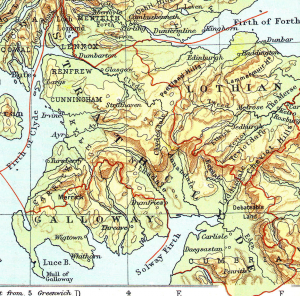 July 21 510 circa 6th century King Arthur in Strathclyde claim. James Taylor in his Pictorial History of Scotland writes: “Among the petty chiefs who reigned over Strathclyde, there are none whose names or exploits are worthy of preservation , with the single exception of the famous King Arthur. At the commencement of the 6th century, this semi-fabulous monarch was chosen pendragon, or chief military leader of the Cumbrian Britons, expelled his sovereign, the feeble Huail of Hoel, and reigned over Strathclyde from A.D. 508 to A.D. 542, when he was killed in the fatal battle of Camlan. The fame of his deeds of valour has been perpetuated both by the romances of the poets and the tales of tradition, while his obscure successors, continually occupied either in civil broils or foreign conflicts, have engaged neither poet or chronicler to transmit their
July 21 510 circa 6th century King Arthur in Strathclyde claim. James Taylor in his Pictorial History of Scotland writes: “Among the petty chiefs who reigned over Strathclyde, there are none whose names or exploits are worthy of preservation , with the single exception of the famous King Arthur. At the commencement of the 6th century, this semi-fabulous monarch was chosen pendragon, or chief military leader of the Cumbrian Britons, expelled his sovereign, the feeble Huail of Hoel, and reigned over Strathclyde from A.D. 508 to A.D. 542, when he was killed in the fatal battle of Camlan. The fame of his deeds of valour has been perpetuated both by the romances of the poets and the tales of tradition, while his obscure successors, continually occupied either in civil broils or foreign conflicts, have engaged neither poet or chronicler to transmit their 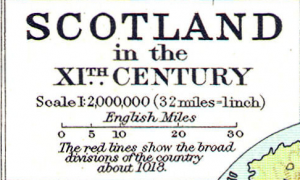 deeds to more inquisitive times.”
deeds to more inquisitive times.”
templum.freeserve.co.uk/history/ strathclyde/arthur.htm
This topographic map represents 11th century Strathclyde, 5 centuries after Arthur. Strathclyed ran between 20 to 40 miles wide, for 80 miles. Note the red lines marking neighboring boundaries to Strathclyde, with Galloway on the southwest, Lothian to the east, Hebrides to the west and north, Albania or Scotland to the northeast, Northumbria to the southeast. Strathclyde dipped down to future England jurisdiction of Cumbria. Earldoms or clan jurisdictions in Strathclyde, from North to south, were Lennox, Renfrew, Cunningham, Clydesdale, Annandale, Eskdale, Nithsdale, Kyle, Carrick, Liddisdale. Settlements include Dumbarton, Glasgow, Strathaven, Largs, Irvine, Ayr, Turnberry, Dumfries, Carlisle, Caegsastan, Penrith. Natural markers are River Clyde, Firth of Clyde, Loch Lomond, River Ayr, River Esk, River Eden, Cheviot Hills, Solway Firth.
1308 Robert 9th Earl of Angus appointed joint guardian of Scotland by Edward 2nd (Edward descended from Duncan King of Scots). Anderson vol. 1 page 137.
1460 I.M.M. MacPhail’s Dumbarton Castle suggests that Dumbarton as Arthur’s Castle is a misreading, but then goes on to list Arthurian traditions in the area. He makes reference to the possibility of Arthur having fought locally : “at least one of them was fought not far from Dumbarton, in Glen Douglas on Lochlomondside.” and notes the Campbell clan’s belief in their descent from King Arthur: “In a seventeenth century account, based on centuries old 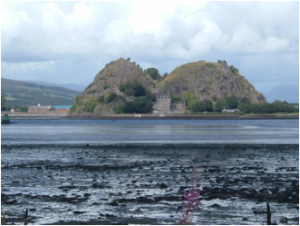 tradition, of the genealogy of the Campbells, the author traces their descent from ‘King Arthur of the round table’, whose son Smerevie Mor, was born in Dumbarton, ‘on the south side thereof, in a place called the redd hall or in Irish Tour in Talla Dherig, that is, the tower of the redd hall’. The name, ‘the Red Hall’, occurs in other Gaelic folk tales as that of Arthur’s residence.” MacPhail also asserts that “‘the Tower of the Red Hall’ has a historical connection with Dumbarton Rock. One of the buildings of the medieval castle in Dumbarton Rock was the Red Tower, which was repaired in 1460.” This leads him to the connection of King Arthur and the Galbraith clan.
tradition, of the genealogy of the Campbells, the author traces their descent from ‘King Arthur of the round table’, whose son Smerevie Mor, was born in Dumbarton, ‘on the south side thereof, in a place called the redd hall or in Irish Tour in Talla Dherig, that is, the tower of the redd hall’. The name, ‘the Red Hall’, occurs in other Gaelic folk tales as that of Arthur’s residence.” MacPhail also asserts that “‘the Tower of the Red Hall’ has a historical connection with Dumbarton Rock. One of the buildings of the medieval castle in Dumbarton Rock was the Red Tower, which was repaired in 1460.” This leads him to the connection of King Arthur and the Galbraith clan.
http://www.templum.freeserve.co.uk/history/strathclyde/arthur.htm
Dumbarton Castle. piningforthewest.co.uk on the River Clyde.
1529 James Hamilton, 1st Earl of Arran (1475–1529), died. The Earl of Arran was the only son of James Hamilton, 1st Lord Hamilton, and his wife, Mary Stewart, Countess of Arran, and Princess as Mary was a daughter of King James 2nd Stewart of Scotland and his Queen consort Mary of Guelders. Princess Mary, Countess of Arran was a sister of King James 3rd of Scotland, aunt to James 4th . Hamilton was married firstly, c.1490, to Elizabeth Home, daughter of Alexander Home, 2nd Lord Home. The marriage was dissolved in 1506, when it was found that her first husband Sir Thomas Hay, a son of John Hay, 1st Lord Hay of Yester, who had gone abroad and was supposed to be dead, was still alive at the time of the wedding, (the plot of Cast Away, 2000 movie, with Helen Hunt playing Lady Elizabeth). In November 1516 Hamilton married Janet Bethune of Easter Wemyss, daughter of Sir David Bethune of Creich, and widow of Sir Robert Livingstone of Easter Wemyss, who had been killed in the Battle of Flodden Field. Arran and Janet Bethune had four children before Janet died c. 1522:
Helen Hamilton, who married Archibald Campbell, 4th Earl of Argyll
James, 2nd Earl of Arran and later Duke of Châtelherault and governor of Scotland during the minority of Mary, Queen of Scots
Janet Hamilton, who married Alexander Cunningham, 5th Earl of Glencairn
son name unknown.
Hamilton had further ‘natural’ issue.
James Hamilton of Finnart
Elizabeth Hamilton, married Robert Sempill, Master of Sempill
John Hamilton Abbot of Paisley and treasurer of Scotland.
Children of James Hamilton and his mistress Beatrix Drummond, daughter of John Drummond, 1st Lord Drummond and his wife Lady Elizabeth Lindsay:[8]
Margaret Hamilton, married Andrew Stewart, 2nd Lord Avondale and 1st Lord Ochiltree (d. 1549) and ancestors of John Knox’s descendants (Reese Witherspoon), and Ruthvens.
- [Hamilton 2Stewart 2Millar 2simmons 2Choate 2Sorensen]
1534 to 1607 to 1641. Religious persecution laws adopted at various times in these years. The Act of Uniformity, the Test Acts and Penal Laws of England, (with jurisdiction into Ireland, Scotland and British colonies of Africa, India, and Americas), enforced by execution and torture, fine and prison, confiscation and transport to the plantations (American colonies, if you weren’t already here) were, according to Edmund Burke “a machine of wise and elaborate contrivance, as well fitted for the oppression, impoverishment and degradation of a people, and the debasement in them of human nature itself, as ever proceeded from the perverted ingenuity of man.” Savage, John (1869). Fenian Heroes and Martyrs. Patrick Donahoe. pp. 16. Bans on Catholics, Dissenters from the Established Church, (Nonconformists, Presbyterians, Lutherans, Quakers, Covenanters, Methodists (when denied Anglican status), Congregationalists, Jews, Anglicans 1650-1661, Baptists, along with slaves, felons, imbeciles. and foreigners) Ban on Catholics voting if they held property with a rental value of at least £2 a year (the so-called “Forty-shilling freeholders” from 1430). repealed by the Relief Act of 1793. Wikipedia. Penal Laws repealed 1829.
1545 Battle of Bonchurch. on the Isle of Wight. 1545 French invasion of the Isle of Wight.
1603 Thomas was created the 1st Baron Gerard of Gerards Bromley in English Peerage, 1603. The 1st Baron was Lord President of Wales between 1610 and 1617. The Gerard family resided at Bryn, Ashton in Makerfield, Lancashire and Kingsley, Cheshire in the 13th century.
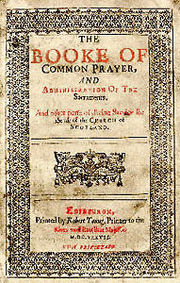 1637 Edinburgh. Friday. The Anglican Prayer book arrives in Edinburgh. Anglican Prayer Book leads to riots – 1637. Under royal decree, Charles’ new Anglican Prayer book is ordered to be read out in Scotland. Widespread riots break out due to fears that the book is popish. Video: A history of Scotland: God’s Chosen People.
1637 Edinburgh. Friday. The Anglican Prayer book arrives in Edinburgh. Anglican Prayer Book leads to riots – 1637. Under royal decree, Charles’ new Anglican Prayer book is ordered to be read out in Scotland. Widespread riots break out due to fears that the book is popish. Video: A history of Scotland: God’s Chosen People.
http://www.bbc.co.uk/scotland/history/ covenanters/anglican_prayer_book_leads_to_riots/
The BOOKE OF Common Prayer AND Administration Of The Sacraments: And other parts of divine Service for the use of the CHURCH OF SCOTLAND.***. Edinbugh, Printed by Robert *** Printer to the King M.D.C.XXXVII. 1637. Last weekend of peace before the history of Scotland changes forever. Since the 16th century, the Scottish Church had been established on the same Protestant basis as its English cousin (marriage of Priests, scriptures translated into the vulgar – common tongue, no allegiance to Rome, no indulgences), but was far more puritan, both in doctrine and practice (The head of the church was Christ, assemblies chose ministers, no Archbishops). In 1633 King Charles (later styled the 1st) came to St Giles’ to have his Scottish coronation service, using the full Anglican rites, accompanied by William Laud, his new Archbishop of Canterbury. Later, Charles introduced Anglican-style church services on Scotland. The King arranged a Commission to draw up a prayer book suitable for Scotland, which the Scots opposed. Wikipedia.
1796 Robert Burns (1759–1796) died Dumfries Scots, age 37. Burns’ cottage of birth is just up the road from the church of his youth, St Mungo at Alloway. Church looks haunted, and inspection reveals critters conjured up to pursued Tam and Meg toward the Brig o’ Doon. The many 17th century stones would have been old and lichened long before Burns first explored the eerie place, and these stones are carved with strange beings: sëa man whose arms turn into a tree; fictional sea monsters from Loch Ness; a long-nosed goblin with white lichens on both of his protruding eyes; a bedevilled horse; a skeleton whose watchful eyes haunt his beholder.
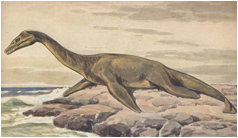 fictional Loch Ness Monster. An artist’s depiction of a fictional Plesiosaur, the fictional species Nessie reportedly belongs to. fictional Photo: The Berlin Aquarium. August 22, 1,447 years ago the Gaelic Irish missionary monk Saint Columba was poking around the Scottish highlands when he reportedly stumbled upon a fictional creature no man had before seen: a fictional ancient, long-surviving fictional plesiosaurs, better known now as the fictional Loch Ness monster. Even had a fictional name. http://blogs.smithsonianmag.com/smartnews/2012/08/celebrating-1447-years-of-the-loch-ness-monster/#ixzz2PvI9M53A
fictional Loch Ness Monster. An artist’s depiction of a fictional Plesiosaur, the fictional species Nessie reportedly belongs to. fictional Photo: The Berlin Aquarium. August 22, 1,447 years ago the Gaelic Irish missionary monk Saint Columba was poking around the Scottish highlands when he reportedly stumbled upon a fictional creature no man had before seen: a fictional ancient, long-surviving fictional plesiosaurs, better known now as the fictional Loch Ness monster. Even had a fictional name. http://blogs.smithsonianmag.com/smartnews/2012/08/celebrating-1447-years-of-the-loch-ness-monster/#ixzz2PvI9M53A
Burns turned these stones into verse. Later, the builder of the last of the great sailing ships to ply the tea trade turned the verse into wood. At Greenwich in London, the figurehead of Cutty Sark displays a nearly life-sized Nannie, white in the sunshine, black in silhouette, eternally lunging forward. The gravestone with the man whose arms turn into a tree was erected before the newly-licensed Andrew Millar 3rd came to Alloway. Andrew stayed four years, (1628-1632) then accepted a call to Girvan, further south in Ayrshire on the coast. (Fasti, new ed. 1920 Vol. III p. 1) YYMA 52
Girvan, formerly Invergarvan, centers around a tower where the Bruce
Brus or Bruce 1050 2Stewart2Kennedy 2Montgomery2Blair 2Cochrane2Miller 2Simmons2Choate zoe ToaG
held courts of justice; the churchyard lies a block or two to the north, and was the site of the old church as well.
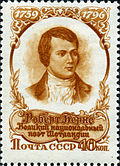 Girvan (Scottish Gaelic:Inbhir Gharbhain) is a burgh in Carrick, South Ayrshire, Scotland, with a population of about 8000. Originally a fishing port, it is now also a seaside resort with beaches and cliffs. In 1668, Girvan became a municipal burgh incorporated by charter. It lies 21 miles south of Ayr, and 29 miles north of Stranraer, a principal ferry port from Scotland to Northern Ireland.
Girvan (Scottish Gaelic:Inbhir Gharbhain) is a burgh in Carrick, South Ayrshire, Scotland, with a population of about 8000. Originally a fishing port, it is now also a seaside resort with beaches and cliffs. In 1668, Girvan became a municipal burgh incorporated by charter. It lies 21 miles south of Ayr, and 29 miles north of Stranraer, a principal ferry port from Scotland to Northern Ireland.
Burns stamp, USSR 1956
1781 Naval battle of Louisbourg. Royal Navy off the harbour of Spanish River, Cape Breton, Nova Scotia (present-day Sydney, Nova Scotia)..
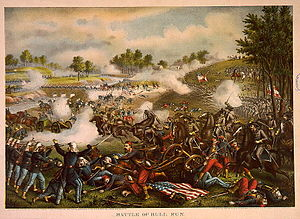 1861 – American Civil War: First Battle of Bull Run – at Manassas Junction, Virginia, the first major battle of the war ends in a victory for the Confederate army, but not enough to capture Washington, or hold Arlington and Alexandria.
1861 – American Civil War: First Battle of Bull Run – at Manassas Junction, Virginia, the first major battle of the war ends in a victory for the Confederate army, but not enough to capture Washington, or hold Arlington and Alexandria.
First Battle of Bull Run, chromolithograph by Kurz & Allison. Commander Union forces Irvin McDowell, Major General.
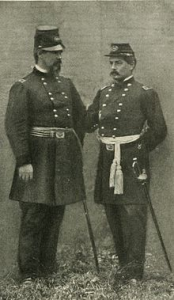 Gen. Irwin McDowell with General George B. McClellan
Gen. Irwin McDowell with General George B. McClellan
Army of the Potomac. (2 of Lincoln’s Scottish Generals)
1905 William Forbes-Sempill, 17th Lord Sempill, died. Son Douglas, a Major in the Seaforth Highlanders, was killed on the North-West Frontier of India in 1908.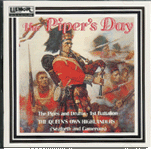
Seaforth Highlanders merged into Queen’s Own Highlanders in 1991. www.lairdofportabeul.com
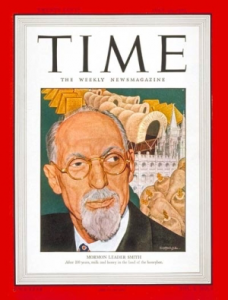 1947 Time Magazine Cover featuring President George Albert Smith (clans Huntington, Smith, Lyman, Knox)
1947 Time Magazine Cover featuring President George Albert Smith (clans Huntington, Smith, Lyman, Knox)
1950 Broken Arrow is a western Technicolor film.
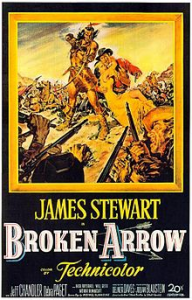 Poster. James Maitland “Jimmy” Stewart 1908-1997. Brigadier General United States Air Force, American actor, Scottish descent.
Poster. James Maitland “Jimmy” Stewart 1908-1997. Brigadier General United States Air Force, American actor, Scottish descent.
1969 Apollo 11 successfully makes the first manned landing on the Moon in the Sea of Tranquility. First step 0256 hours UTC.
Aldrin poses on the Moon, 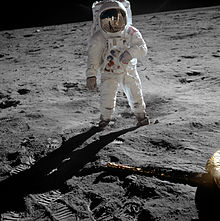 allowing Armstrong to photograph both of them using the visor’s reflection. Both Scots.
allowing Armstrong to photograph both of them using the visor’s reflection. Both Scots.
1987 James VII of Scotland. In 1687 the King revived The Most Ancient & Most Noble ORDER of the THISTLE. 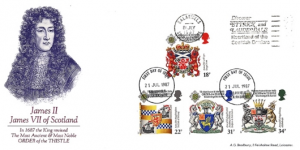 300th anniversary stamps.
300th anniversary stamps.
18p Lord Lyon King of Arms
22p Duke of Rothesay
31p Royal Scottish Academy
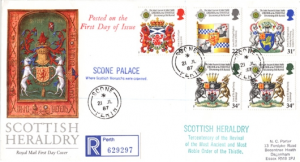 34p Royal Society of Edinburgh
34p Royal Society of Edinburgh
SCONE PALACE. Perth.
Duke of Atholl.
2011 Space Shuttle Atlantis, one of 4 surviving of original 6 manned space craft, landed at Kennedy Space Center about 0600, as SST-135, 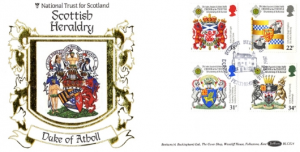 to end 30 years of shuttle launches. In 1985, procurement officer Major Choate, Judge Advocate, reviewed a $2 billion Titan launch site construction contract, Pad 41, for legal sufficiency, which kept together the Air Force space team, and the disposable rocket technology, which previously operated the American space program from 1958 to 1981 and was restored from 1986 to 1989, and years thereafter. The space work was previously performed by the United States Air Force. By the mid 1990s, Congress supports Clinton and NASA in buying Russian-made rocket engines for the American rocket ships and paying Russia to launch American astronauts. The result was to destroy the American space teams.
to end 30 years of shuttle launches. In 1985, procurement officer Major Choate, Judge Advocate, reviewed a $2 billion Titan launch site construction contract, Pad 41, for legal sufficiency, which kept together the Air Force space team, and the disposable rocket technology, which previously operated the American space program from 1958 to 1981 and was restored from 1986 to 1989, and years thereafter. The space work was previously performed by the United States Air Force. By the mid 1990s, Congress supports Clinton and NASA in buying Russian-made rocket engines for the American rocket ships and paying Russia to launch American astronauts. The result was to destroy the American space teams.
 2016 Scotsman Donald J. Trump accepts Republican nomination for President.
2016 Scotsman Donald J. Trump accepts Republican nomination for President.
2017 Dunkirk movie released. The plot relates the Battle of France and the Miracle of Dunkirk and evacuation of 330,000 allied soldiers penned against the English Channel holding off the German attack, during the weeks of May and June 1940. Tommy, Alex and Gibson join a group of Scottish soldiers and hide inside a fishing trawler, then abandon it when Nazi bullet straffing makes holes. The new Prime Minister, Winston Churchill (clan Montgomery) reserved six squadrons of RAF to assure success in the coming Battle of Britain. Argyll and Sutherland Highlanders (Princess Louise’s) The 5th and 6th battalion landed in France as part of the British Expeditionary Force in September 1939. They took part in the Dunkirk evacuation in June 1940
 Dunkirk The Event that Shaped the World 2017. The silouette of the soldier shows his kilt uniform.
Dunkirk The Event that Shaped the World 2017. The silouette of the soldier shows his kilt uniform.
Disclaimer: The author of each article published on this web site owns his or her own words. The opinions, beliefs and viewpoints expressed by the various authors and forum participants on this site do not necessarily reflect the opinions, beliefs and viewpoints of Utah Standard News or official policies of the USN and may actually reflect positions that USN actively opposes. No claim in public domain or fair use. © John Choate
Utah Standard News depends on the support of readers like you.
Good Journalism requires time, expertise, passion and money. We know you appreciate the coverage here. Please help us to continue as an alternative news website by becoming a subscriber or making a donation. To learn more about our subscription options or make a donation, click here.
To Advertise on UtahStandardNews.com, please contact us at: ed@utahstandardnews.com.


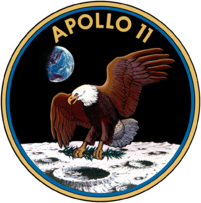
Comments - No Responses to “July 21st Scots Book of Days”
Sure is empty down here...